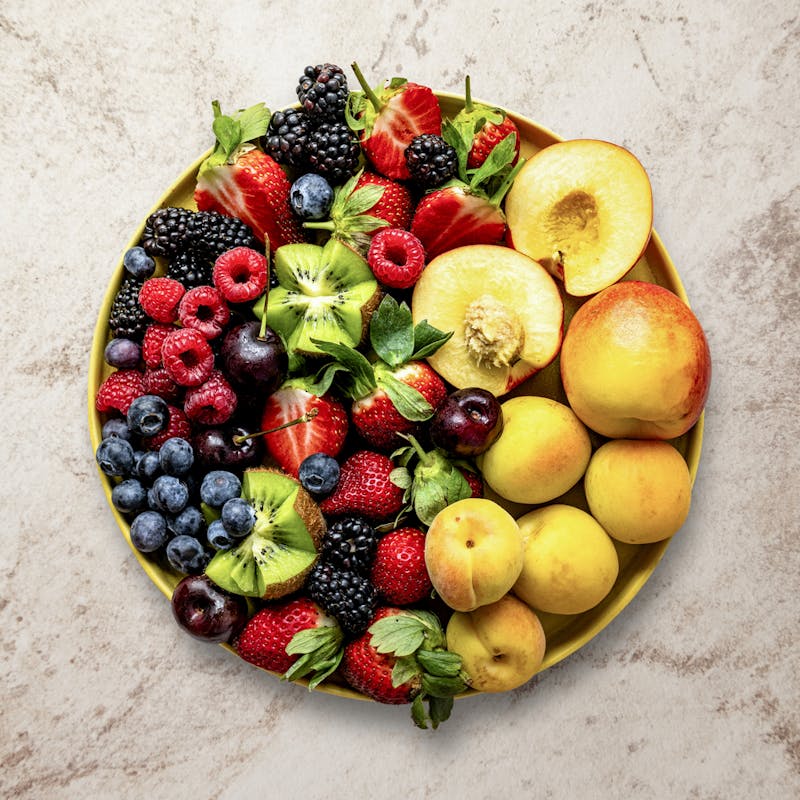
The heat is on! As you head outside to enjoy the summer sun, you must ensure you’re adequately hydrated. We often think of what we should drink to hydrate our bodies, but with temperatures regularly over 100—what you eat matters too. Let’s explore the most hydrating foods to add to your diet, as well as what to drink.
How Much Hydration Does Your Body Need?
Let’s begin with the basics of how much water (or hydrating fluids) you should be consuming daily. The general rule is 8 glasses of 8 ounces of water per day. This is actually a bit short of what you need per day, assuming that you’ll obtain your remaining hydration from fruits, vegetables, and hydrating foods.
Since nothing about health and nutrition is one-size-fits-all, aim to drink closer to half of your body weight in hydrating fluids per day.
Even if it’s not hot out, drink more if:
- You feel thirsty.
- If you’re perspiring heavily.
- As a proactive approach to dehydrating circumstances.
- You’re prescribed a medication that is dehydrating.
- You have a health condition that dehydrates you.
How Much More Hydration Do You Require in the Summer?
The hotter it is out, the more your body will perspire in an effort to self-regulate your body temperature. As such, the more you’ll need to drink or eat foods that hydrate.
To replenish the water content in your body, drink approximately 8 ounces of water every 15 to 20 minutes in hot weather. This is in addition to your year-round fluid intake. Drinking this frequently might not be possible if you’re working, exercising, or playing sports—but aim for at least 16 ounces per hour. Just be mindful that if you drink too much at once while active, you may get a stomach cramp.
The longer you’ll be outside, the more you need to add electrolytes to the mix. You can obtain your electrolytes from sports drinks, electrolyte powder, coconut water, and many fruits and vegetables. Aim for 8 to 16 ounces of electrolytes after working out or while in the heat. Or as a proactive approach before an extended workout or any time you’ll be perspiring heavily.
If you’re thirsty, you’re dehydrated or heading in that direction. Drink before you feel thirsty.
Signs of dehydration:
- Feeling thirsty
- Dark yellow, strong-smelling urine
- Urinating less than every 2 to 3 hours
- Feeling dizzy or lightheaded
- Feeling tired
- Dry mouth, lips, and tongue
- Sunken eyes
What Are Electrolytes?
The water content in hydrating foods and beverages isn’t the only hydrating factor, as your body also requires electrolytes. Electrolytes are essential minerals that you lose in excessive amounts when your body perspires.
Restoring your electrolyte levels is essential for ensuring the fluids you drink can easily permeate your cells. If you only drink water, your body may not be able to achieve an optimal balance of water inside or outside of your cells.
Essential electrolytes include:
- Sodium
- Potassium
- Chloride
- Calcium
- Magnesium
- Phosphate
- Bicarbonate
Signs your body needs more electrolytes:
- Insatiable thirst
- Muscle cramps
- Unexplained headache
- Stomachache
What Helps Your Body Hydrate Faster?
Drinking hydrating foods and beverages with electrolytes is the fastest way to rehydrate. Also consider IV or vitamin therapy when you’ll be exerting significant energy, sweating heavily, or you just can’t quench your thirst. Many athletes turn to customized vitamin therapy after a marathon or game, but IV and vitamin therapy are available to everyone!
What Foods Hydrate You the Most?
Now that you know how much to drink when it’s hot or when you’ll be perspiring, let’s explore what to eat. Many of the foods above double as electrolytes. We discuss electrolyte beverages and other functional beverages further below.
What Foods Help With Adequate Hydration?
Ever wondered why gazpacho, smoothies, fruit juice, leafy greens, and fruit salad are so popular in the summer? It’s because they’re all hydrating foods!
Be sure to prioritize the fruits and veggies below during the summer months, ideally exceeding 5 servings per day when it’s hot out.
Hydrating Fruits & Vegetables
- Apples
- Bell peppers
- Berries
- Cantaloupe
- Cauliflower
- Celery
- Cucumber
- Honeydew
- Kiwi
- Leafy greens
- Mushrooms
- Nectarines
- Oranges
- Papaya
- Peaches
- Pineapple
- Strawberries
- Tomatoes
- Watermelon
- Zucchini
Hydrating Foods
- Bone broth
- Broth-based soups
- Fresh veggie smoothies
- Freshly squeezed juice
- Gazpacho
- Natural yogurt
- Skim milk
How Many Electrolyte Beverages Should You Drink When It’s Hot?
When it comes to electrolytes, more isn’t better. Even if you’re perspiring heavily, one to two sports drinks or servings of coconut water should be enough to replenish your electrolytes. Be mindful that 1 sports beverage may be 2 (or more) servings.
Again, this should be personalized, so if you frequently perspire for extended periods of time or work out for more than 1 hour at a time—consider seeking the advice of a nutritionist. Not just for hydration, but for a meal plan that’s tailored to your individual needs.
Be mindful of the sugar in electrolyte beverages
Another consideration is the sugar content of electrolyte beverages. Depending on your level of physical activity, you may be able to consume a bit more sugar than usual during your workout, just before your workout, or an hour or so after your workout. Sugar is an energy source. The negative effects of sugar arise when you consume more sugar than your body can burn. So, when you burn more energy than usual, you can typically consume a bit more sugar without harm.
On the flip side, consuming too much sugar can be dehydrating. Refined sugars can also negatively impact your physical performance and contribute to a range of health concerns. So, the quality of your sugar and the timing of sugar consumption surrounding high-intensity exercise must be personalized.
Are Beverages With Monk Fruit Really Sugar-Free?
Yes! Monk fruit and allulose sugar are two exciting natural alternatives to table sugar, processed sugar, and artificial sweeteners.
- Monk fruit—the monk fruit contains a rare antioxidant known as mogrosides. One of the things that makes this antioxidant unique is that it’s 100 to 250 times sweeter than sugar! So, it can sweeten foods and beverages without causing your blood glucose to spike—and without the risks associated with traditional sugar.
- Allulose—allulose is a unique naturally occurring type of sugar found in wheat, molasses, maple syrup, figs, and raisins. What makes this sugar unique is that your body metabolizes it so fast that it doesn’t cause your blood sugar to spike.
So, zero-sugar beverages sweetened with monk fruit or allulose can be hydrating! Consider using both sugars for cooking and baking.
What to Drink Other Than Electrolytes?
Now that you know what hydrating foods and fruits to eat, you might be wondering what to drink in addition to water.
- Fruit or herb-infused water
- Unsweetened herbal tea
- Zero-sugar sparkling water
- Low or zero-sugar functional beverages.
Refreshing Mint Tea Recipe
Mint is a naturally cooling herb. Instead of drinking it hot, make a cold mint tea!
- Fill a pitcher with cold or room-temperature water.
- Place 4 or 5 peppermint, spearmint, or other mint tea bags inside. Secure the strings to the side of the pitcher or carefully remove them.
- Steep in the fridge for at least 4 hours.
- Remove the tea bags and drink cold within the next 3 days.
Does Drinking Something Hot Cool You Down?
Ever heard that drinking something hot on a hot day will cool you down? There’s some truth to this!
The University of Ottawa completed a study that found that if you drink something hot before you begin to perspire—it can help you stay cooler when you head out in the heat or begin to sweat. The heat in your beverage activates your body’s sweat response. While this might not seem beneficial, it creates less stored heat inside of your body. This helps to keep you a bit cooler when it’s hot.
So, drink some piping hot herbal tea, lemon water, or a cup of unsweetened coffee in the morning. Once you feel the heat or begin to sweat, cold beverages and cold hydrating foods will feel more refreshing.
What Not to Eat or Drink When It’s Hot?
The foods below can raise your body temperature or increase your risk of dehydration. So, keep them to a minimum when it’s hot and humid.
- Spicy foods
- Fried foods
- Alcohol
- High-sugar foods and beverages
- Red meat
- Caffeine
How to Stay Cool on a Hot Day?
- If possible, time your activity to the coolest time of the day.
- Wear a hat and stay in the shade as much as possible.
- Wear clothing that is both cooling and sweat-wicking.
- Utilize outdoor commercial fans and handheld fans.
- Jump in cold water or use a hose or spray bottle with cold water.
- Use cooling towels, ice, and ice packs to cool down.
- Take breaks in an air conditioned space or space with fans.
How to Recover After a Hot Day?
- Cool down in air conditioning or with cold water.
- Cleanse the sweat off your body with a cool shower.
- Rehydrate with cold electrolytes, hydrating foods, and water.
- Get a good night’s rest to help your body recover.
- Kick whole-body topical antioxidants up a notch to repair sun damage.
- Avoid alcohol, caffeine, and greasy foods after a hot day.
Here’s to an active, fun, and safe summer!

